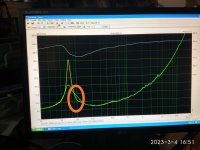Greeting,
I'm converting some vintage speakers to stereo sub duty. In this case there are 4 10" woofers in a sealed enclosure. The original design consisted of the woofers and six tweets and a super tweet. For unknown reasons one appears to have about half the stuffing of the other. So I was wondering how to go about tuning or matching them to each other by adjusting the stuffing. I do intend on perhaps running them up to 250hz on occasion. So the range will be roughly 21-250hz. So I suspect removal of the existing stuffing wouldn't be advisable. I'm thinking of trying the click test method but boosting the battery up to 3vdc due to having multiple drivers in play. So with the click test are you tuning for maximum scratch and snap? Are there any other simple audible or electrical test that I'm overlooking?
Many thanks in advance,
DD
I'm converting some vintage speakers to stereo sub duty. In this case there are 4 10" woofers in a sealed enclosure. The original design consisted of the woofers and six tweets and a super tweet. For unknown reasons one appears to have about half the stuffing of the other. So I was wondering how to go about tuning or matching them to each other by adjusting the stuffing. I do intend on perhaps running them up to 250hz on occasion. So the range will be roughly 21-250hz. So I suspect removal of the existing stuffing wouldn't be advisable. I'm thinking of trying the click test method but boosting the battery up to 3vdc due to having multiple drivers in play. So with the click test are you tuning for maximum scratch and snap? Are there any other simple audible or electrical test that I'm overlooking?
Many thanks in advance,
DD
Greets!
The click test is about no 'hangover' (over damped) or 'boom' (under damped), i.e. just a 'click' to indicate transient perfect.
The click test is about no 'hangover' (over damped) or 'boom' (under damped), i.e. just a 'click' to indicate transient perfect.
Same speaker with different ,more, staffing.
How we can recognise the ideal staffing?
How we can recognise the ideal staffing?
Attachments
Last edited:
IIRC you need to use an impulse response with a 'perfect' trace having no negative dip; then again..........., so maybe best to do a bit of Googling
Last edited:
Thank for the interesting replies. I kinda brushed off puters decades ago, after envisioning this current bubble. But that's darn interesting, and perhaps I should consider some analytical software. So is there a useful frequency limit for the battery tweek by ear method?
DD
DD
If I understand the Q, depends on the person, i.e. the higher in frequency one goes, this man relied on women and children for the higher frequencies as my hearing became compromised pretty much from day one since my dad was a racing enthusiast, so with post WWII racing being mostly up close and 'personal' dirt track ovals and early NASCAR events + dragsters by the mid '50s combined with 500 lb TNT bomb simulations at Fort Benning, not to mention some of the many incredibly loud Concerts I've experienced, I'm surprised I can still hear at all without hearing aids.
Last edited:
- Home
- Loudspeakers
- Subwoofers
- Methods for determining proper stuffing volume in matched sealed boxes

